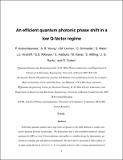Files in this item
An efficient quantum photonic phase shift in a low Q-factor regime
Item metadata
| dc.contributor.author | Androvitsaneas, Petros | |
| dc.contributor.author | Young, Andrew | |
| dc.contributor.author | Lennon, Joseph | |
| dc.contributor.author | Schneider, Christian | |
| dc.contributor.author | Maier, Sebastian | |
| dc.contributor.author | Hinchliff, Janna | |
| dc.contributor.author | Atkinson, George | |
| dc.contributor.author | Harbord, Edmund | |
| dc.contributor.author | Kamp, Martin | |
| dc.contributor.author | Höfling, Sven | |
| dc.contributor.author | Rarity, John G. | |
| dc.contributor.author | Oulton, Ruth | |
| dc.date.accessioned | 2020-01-11T00:36:07Z | |
| dc.date.available | 2020-01-11T00:36:07Z | |
| dc.date.issued | 2019-02-20 | |
| dc.identifier | 257340400 | |
| dc.identifier | 2bd31e48-0b7e-4c54-a453-f9071b5ae6a8 | |
| dc.identifier | 85062067071 | |
| dc.identifier | 000459642800026 | |
| dc.identifier.citation | Androvitsaneas , P , Young , A , Lennon , J , Schneider , C , Maier , S , Hinchliff , J , Atkinson , G , Harbord , E , Kamp , M , Höfling , S , Rarity , J G & Oulton , R 2019 , ' An efficient quantum photonic phase shift in a low Q-factor regime ' , ACS Photonics , vol. 6 , no. 2 , pp. 429-435 . https://doi.org/10.1021/acsphotonics.8b01380 | en |
| dc.identifier.issn | 2330-4022 | |
| dc.identifier.other | RIS: urn:40181A681244B60ACC9C8FDE0D77F56D | |
| dc.identifier.uri | https://hdl.handle.net/10023/19261 | |
| dc.description | This work was funded by the Future Emerging Technologies (FET)-Open FP7-284743 [project Spin Photon Angular Momentum Transfer for Quantum Enabled Technologies (SPANGL4Q)] and the German Ministry of Education and research (BMBF) and Engineering and Physical Sciences Research Council (EPSRC) (EP/M024156/1, EP/N003381/1 and EP/M024458/1). J.J.H. was supported by the Bristol Quantum Engineering Centre for Doctoral Training, EPSRC grant EP/L015730/1. We acknowledge the GW4 network for funding of A.Y. | en |
| dc.description.abstract | Solid-state quantum emitters have long been recognised as the ideal platform to realize integrated quantum photonic technologies. We demonstrate that a self-assembled negatively charged quantum dot (QD) in a low Q-factor photonic micropillar is a suitable design for deterministic polarisation switching and spin-photon entanglement. We show this by measuring a shift in phase of an input single photon of at least 2π/3. As we explain in the text, this is strong experimental proof that input photons can interact with the emitter deterministically. A deterministic photon-emitter interaction is a viable and scalable means to achieve several vital functionalities such as single photon switches and entanglement gates. Our experimentally determined value is limited by mode mismatch between the input laser and the cavity, QD spectral fluctuations and spin relaxation. When on-resonance we estimate that up to ∼80% of the collected photons couple into the cavity mode and have interacted with the QD and undergone a phase shift of π. | |
| dc.format.extent | 661844 | |
| dc.language.iso | eng | |
| dc.relation.ispartof | ACS Photonics | en |
| dc.subject | QC Physics | en |
| dc.subject | NDAS | en |
| dc.subject.lcc | QC | en |
| dc.title | An efficient quantum photonic phase shift in a low Q-factor regime | en |
| dc.type | Journal article | en |
| dc.contributor.institution | University of St Andrews. Condensed Matter Physics | en |
| dc.contributor.institution | University of St Andrews. School of Physics and Astronomy | en |
| dc.identifier.doi | 10.1021/acsphotonics.8b01380 | |
| dc.description.status | Peer reviewed | en |
| dc.date.embargoedUntil | 2020-01-11 |
This item appears in the following Collection(s)
Items in the St Andrews Research Repository are protected by copyright, with all rights reserved, unless otherwise indicated.

